Choosing the right replacement filter for your air purifier is essential for keeping your indoor air clean and fresh. Start by identifying the type of contaminants you want to tackle, like allergens or odors. Look for HEPA filters for particles and activated carbon filters for smells. Always check the size and performance ratings, like MERV or FPR, to guarantee a proper fit and efficient operation. Consider your budget, as replacement costs can vary greatly. Regular maintenance is key, so keep an eye on filter indicators. There's a lot more you can explore to find the perfect filter for your needs.
Key Takeaways
- Identify the type of filter needed (HEPA, activated carbon, etc.) based on your specific air quality issues, such as allergens or odors.
- Ensure the replacement filter matches the correct dimensions by consulting manufacturer specifications to prevent air leaks.
- Monitor and replace filters regularly: HEPA filters every 6-12 months and activated carbon filters every 3 months for optimal performance.
- Consider the cost implications of replacement filters, balancing initial price with long-term maintenance expenses.
- Utilize accessories like pre-filters and filter subscription services to enhance efficiency and ensure timely replacements.
Understanding Air Purifier Filters
When it comes to air purifier filters, understanding their roles is key for maintaining a healthy indoor environment. Air purifier filters are essential for capturing airborne pollutants that can affect your indoor air quality.
HEPA filters are particularly important, as they're designed to capture 99.97% of particles as small as 0.3 microns. This makes them highly effective against allergens, providing relief for those with allergies or asthma. Additionally, many air purifiers, such as Levoit models, feature multiple filtration stages that enhance overall air cleaning efficiency.
On the other hand, activated carbon filters excel at trapping odors and volatile organic compounds (VOCs), which can be detrimental to your health. However, these filters require more frequent replacement due to their limited absorption capacity.
To enhance the efficiency of your air purifier, some models include pre-filters. These capture larger particles like hair and dust, prolonging the lifespan of the main filters.
To choose the right filter, you need to take into account your specific air quality concerns. Are you primarily dealing with allergens or unpleasant odors? By understanding the distinct roles of HEPA and activated carbon filters, you can effectively select the appropriate filter type to improve your indoor air quality.
Types of Air Filters
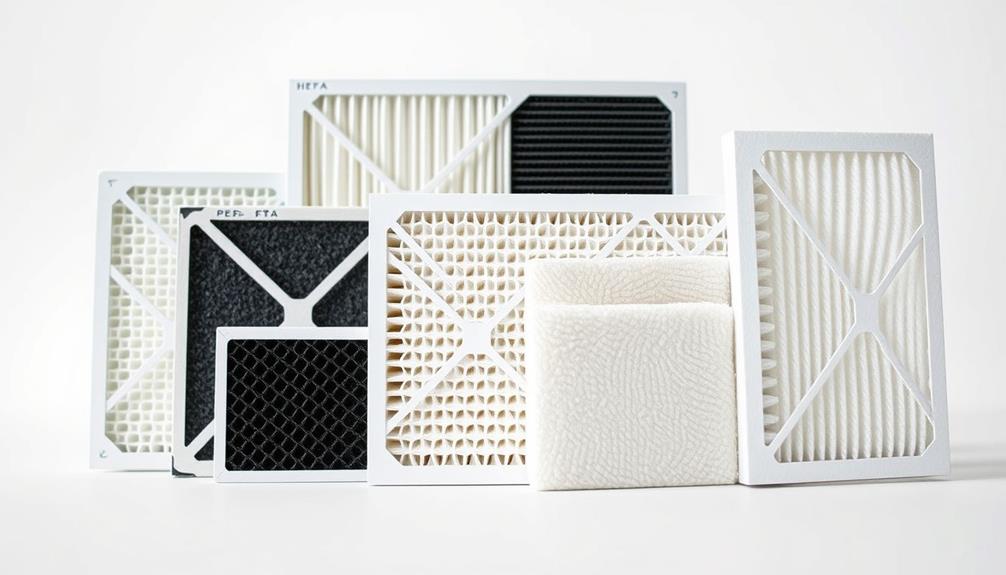
What types of air filters are available to enhance your indoor air quality? Choosing the right filter can make a considerable difference in how clean and healthy your air is. Here's a quick overview of some popular filter types:
– HEPA Filters: These are excellent for capturing 99.97% of particles as small as 0.3 microns, making them ideal for allergens like dust, pollen, and pet dander.
Additionally, using essential oils for relaxation can complement your air purification efforts by improving overall well-being and reducing stress in your indoor environment.
- Activated Carbon Filters: If odors and volatile organic compounds (VOCs) are your concern, these filters excel at trapping unwanted smells from pets, cooking, and smoke.
- UV-C Filters: Utilizing ultraviolet light, these filters neutralize airborne pathogens like viruses and bacteria, giving your air purifying system a germicidal boost.
- Ionic Filters: These emit charged ions that attract and neutralize airborne pollutants. However, be cautious, as they can produce ozone in high concentrations.
- Pre-Filters: Acting as the first line of defense, pre-filters capture larger particles like hair and lint, which helps extend the life of your main filters.
Selecting the right type for your needs can considerably improve your indoor air quality.
Air Filter Performance Ratings
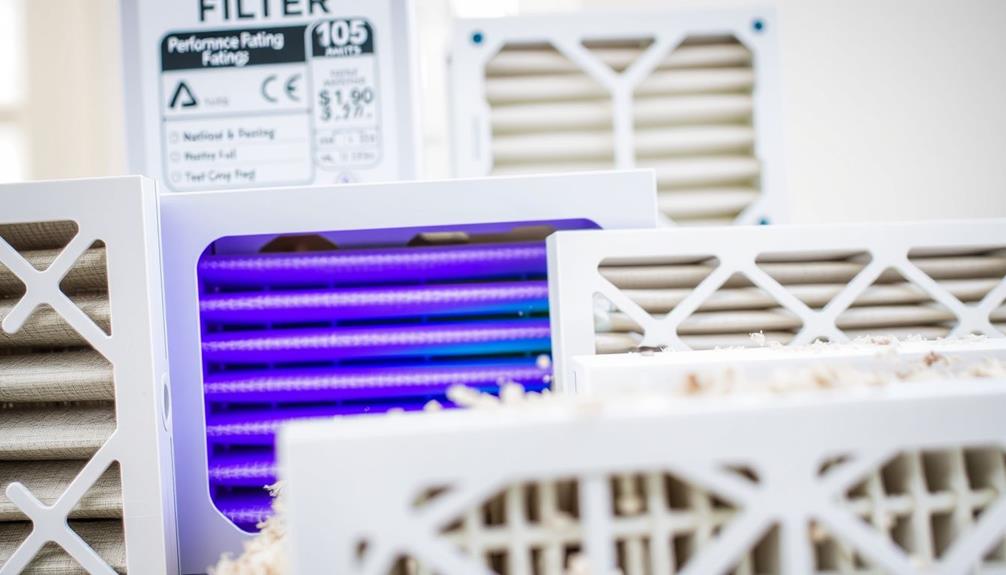
Understanding air filter performance ratings is vital for selecting the most effective option for your needs. Two common systems used to evaluate air filters are the Minimum Efficiency Reporting Value (MERV) and the Home Depot Air Filter Performance Rating (FPR).
MERV ratings range from 1 to 20, and for residential use, a MERV of 6 or higher is recommended, with MERV 8 being quite standard. Additionally, just as cats have specific preferences for their environment, air quality can considerably impact overall well-being, making it essential to choose the right filter research shows cats can recognize their owner's voice and scent.
On the other hand, the FPR system ranks filters from 1 to 12 based on their particle capture ability, considering large particle capture (60%), small particle capture (30%), and weight gain (10%) to determine overall filter effectiveness. Remarkably, an FPR of 10 is comparable to a MERV 20 rating, indicating superior filtration performance.
When choosing a filter, remember that an FPR of 1 doesn't equal a MERV rating of 1; these systems measure filter performance differently.
Evaluating Filter Size
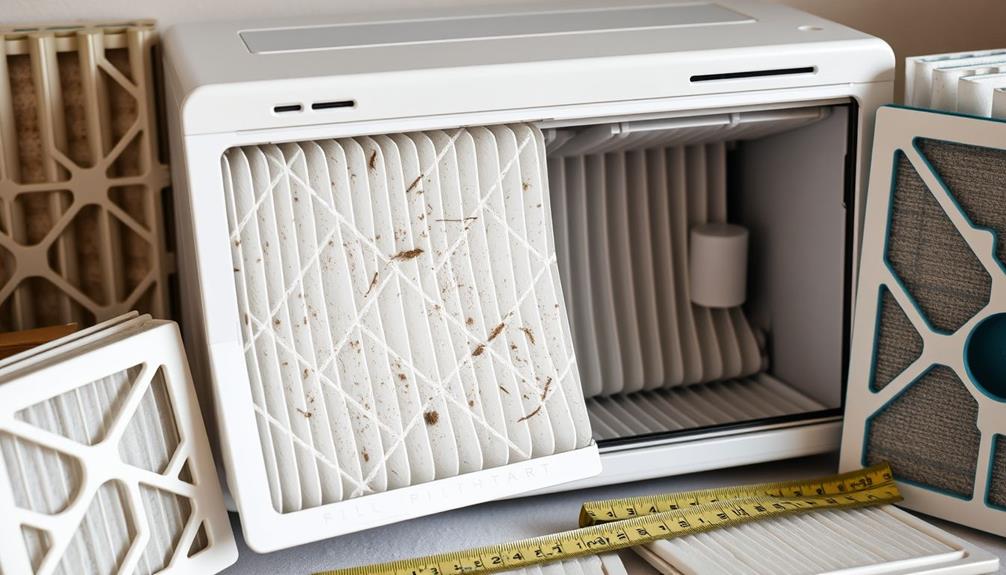
When you're choosing a replacement filter, understanding the dimensions is key.
It's important to take into account the specific requirements of your air purifier model, as different units may have unique filter specifications.
You need to make certain you're measuring both the nominal and actual sizes to guarantee a proper fit.
A filter that doesn't fit right can compromise your air purifier's efficiency, so getting it right is essential.
For additional insights on selecting the right service for your needs, check out key factors in choosing a home cleaning service.
Understanding Filter Dimensions
Choosing the right filter size for your air purifier is essential for maintaining its efficiency and effectiveness. Understanding filter dimensions can help you make an informed choice. Filters are measured in nominal sizes, which are approximate, and actual sizes, which are exact. It's important to verify both when selecting a replacement filter.
Additionally, a well-maintained air purifier can contribute to the overall safety and comfort of your home, similar to the benefits of having a reliable home security system.
Here are a few tips to keep in mind:
- Know common nominal sizes: Popular dimensions include 16 x 25 x 1, 20 x 25 x 1, and 20 x 20 x 1.
- Check thicknesses: Filters come in varying thicknesses, ranging from less than 1 inch to 6 inches.
- Refer to manufacturer's specifications: Always consult the specifications for your air purifier to confirm you're getting the correct filter dimensions.
A proper fit is essential, as incorrect filter sizes can lead to inefficiency and reduced filtration performance. If your air purifier requires a unique size, custom filters are available, and subscription services can help guarantee you receive the right filter dimensions on a regular basis.
Importance of Proper Fit
Proper fit is vital for guaranteeing your air purifier operates at peak efficiency. When you choose replacement filters, you need to focus on matching the exact size required by your air purifier model. Filters are measured in both nominal and actual sizes, so it's important to verify specifications to achieve ideal performance.
Common sizes like 16 x 25 x 1 or 20 x 20 x 1 might be standard, but using an improperly sized filter can result in air leaks and allow unfiltered air to circulate throughout your home. Additionally, selecting the right filter can enhance the overall air quality in your home, similar to how garage door openers improve security and convenience.
If your air purifier requires a unique size, don't worry—custom size filters are available. These options guarantee that even less common dimensions can secure a proper fit, allowing your unit to function effectively.
To make your life easier, consider subscribing to a service that delivers replacement filters automatically. This way, you can consistently maintain the correct size and type, reducing the risk of using the wrong filters in your air purifier.
Measuring Nominal Vs. Actual
Understanding the difference between nominal and actual filter sizes is vital for selecting the right replacement for your air purifier. Nominal sizes are the approximate dimensions you'll often see, like 16 x 25 x 1 or 20 x 20 x 1. However, actual sizes can vary slightly from these figures, which can lead to issues if you're not careful.
Selecting the correct filter size is critical for maximum air quality, similar to how hydration strategies are important for metabolism during physical activities.
Here's what you need to keep in mind when evaluating air filters:
- Fit Matters: An improperly fitting filter can create gaps, reducing the filtration effectiveness.
- Check Specifications: Always refer to the manufacturer's guidance on nominal versus actual sizes.
- Measure Twice: Use precise measurements to confirm you choose the right replacement filter.
Getting the right size is essential for maintaining airflow and making sure your purifier operates effectively. A mismatch hinders filtration and can make your air quality worse instead of better.
Specific Air Quality Needs
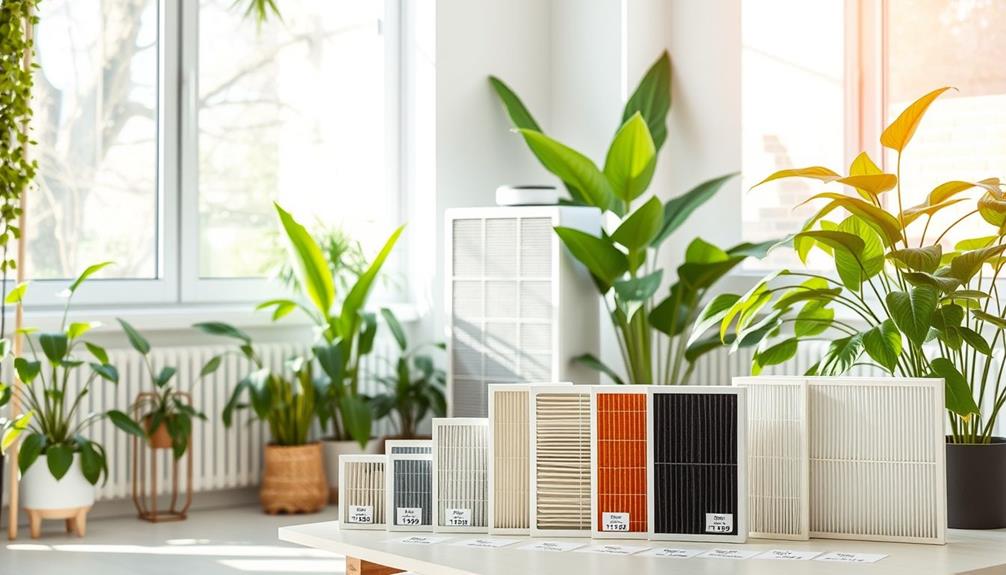
When you think about your air quality needs, consider what specific issues you're facing, like allergies or unpleasant odors.
For pet owners, understanding the impact of dog health and nutrition can also be essential, as pet dander can contribute to allergies.
If you're dealing with allergens, HEPA filters are your best bet for catching tiny particles.
For pet owners or those sensitive to cooking smells, activated carbon filters can tackle those odors effectively, ensuring your home feels fresh and clean.
Allergies and Asthma Management
For those managing allergies and asthma, selecting the right air purifier filter is vital in maintaining a healthy indoor environment. HEPA filters play an essential role, capturing 99.97% of particles as small as 0.3 microns, which includes common allergens like dust mites, pollen, and pet dander.
Additionally, guaranteeing proper ventilation and minimizing indoor pollutants can further enhance air quality, especially in homes with plumbing issues that may contribute to mold growth. Regularly replacing air purifier filters, typically every 6-12 months, can notably reduce airborne irritants and improve indoor air quality, especially in environments where clogging remedies might be necessary to mitigate moisture issues.
When choosing replacement filters, keep these key points in mind:
- Check the CADR rating: A higher Clean Air Delivery Rate indicates more effective removal of allergens and pollutants.
- Consider combination filters: Using HEPA filters alongside activated carbon filters can help eliminate odors that might trigger allergic reactions or asthma symptoms.
- Monitor air quality: Adjusting your air purifier settings based on quality sensors guarantees peak performance against fluctuating allergen levels.
Odor Control Requirements
Air quality isn't just about filtering out allergens; effective odor control is equally important, especially in homes where cooking, pets, or smoke contribute to unpleasant smells.
If you're dealing with strong odors, activated carbon filters are vital. These filters are specifically designed to trap odors, making them a must-have for households with sensitive residents or those who suffer from allergies or respiratory conditions.
Incorporating a holistic lifestyle approach can also help improve overall well-being, which indirectly contributes to a fresher indoor environment, as discussed in menopause management.
To achieve ideal odor control, you should look for air purifiers that combine HEPA filters with activated carbon filters. This combination not only captures airborne particles but also reduces unpleasant smells, greatly improving your indoor air quality.
Keep in mind that not all air purifiers are created equal when it comes to odor removal, so choose one that fits your specific needs.
Regularly replacing your activated carbon filters is essential, typically every 3 to 6 months, to guarantee they remain effective in absorbing odors.
Maintenance and Replacement
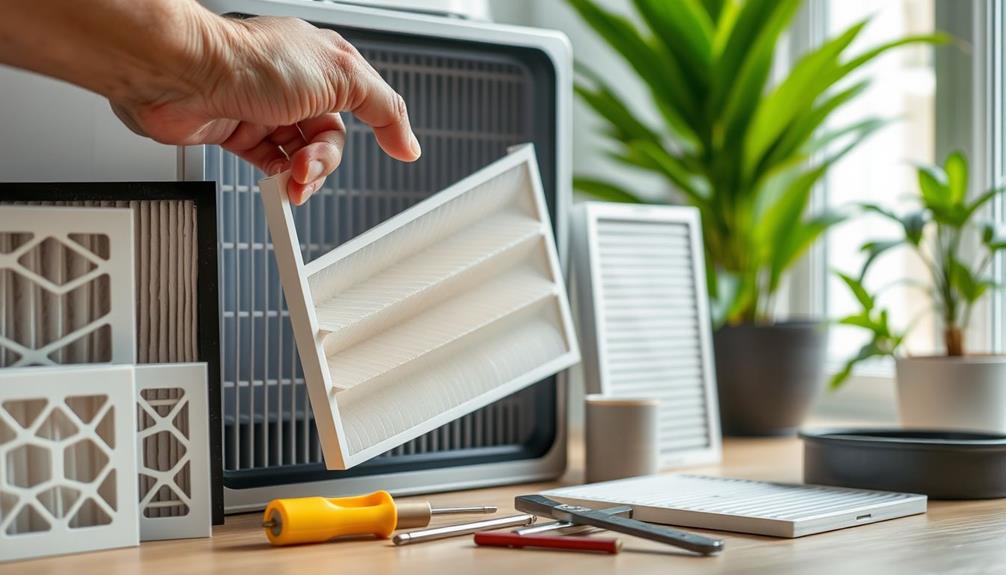
Maintaining your air purifier is crucial for guaranteeing it operates at peak efficiency, and regular filter replacement plays a significant role in that. HEPA filters typically need replacement every 6-12 months, while activated carbon filters may require changes every 3 months due to their odor absorption capabilities.
To keep your air purifier functioning at its best, consider these maintenance tips:
- Check the manufacturer's recommendations for your specific model to know the right maintenance schedules.
- Pay attention to filter service indicator lights that alert you when it's time to replace or clean the filters.
- Clean washable filters regularly to prolong their lifespan and enhance air purification effectiveness.
Investing in high-quality filters not only improves performance but can also reduce the frequency and cost of replacements over time.
Remember, proper maintenance is crucial. By staying on top of your air purifier's filters, you can guarantee a healthier indoor environment and better air quality.
Don't neglect this aspect of your home care routine; your lungs will thank you!
Cost Considerations

Understanding the costs associated with replacement filters is essential for effective air purifier maintenance. Replacement filter costs can vary widely, typically ranging from $20 to over $200, depending on the type and brand.
HEPA filters generally need replacement every 6 to 12 months, while activated carbon filters require changing every 3 months due to odor absorption.
When budgeting for filter replacement, consider the ongoing costs, as these can accumulate and impact your overall affordability for maintaining an air purifier. It's vital to factor in these maintenance expenses when selecting your model.
Some air purifiers may have lower upfront costs but could lead to higher ongoing expenses due to frequent filter changes.
Additionally, investing in an Energy Star certified air purifier can help reduce long-term energy costs, as these models are at least 40% more energy-efficient than standard ones. This can offset some of the filter replacement expenses you might face.
Ultimately, understanding these cost considerations will help you make a more informed decision, ensuring you choose an air purifier that fits both your needs and your budget.
Accessories for Air Filters
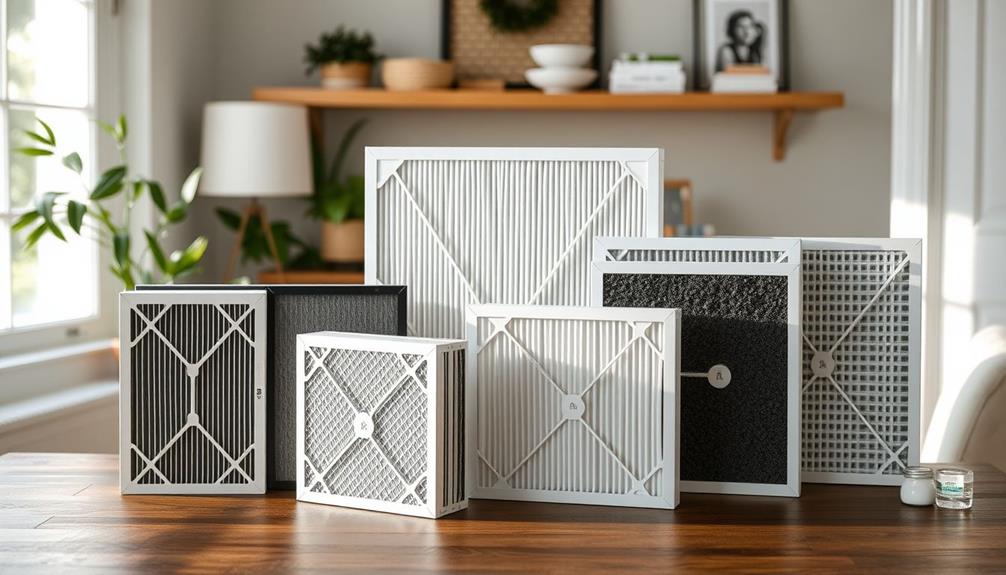
When it comes to air filters, various accessories can greatly enhance your air purifier's performance.
From pre-filters that catch larger particles to maintenance tools that help keep everything running smoothly, these additions can make a real difference.
Plus, understanding the benefits of each accessory guarantees you get the most out of your investment in clean air.
Types of Accessories
Choosing the right accessories for your air purifier can greatly enhance its performance and lifespan. Some essential accessories can help you maintain cleaner air and reduce costs in the long run. Here are a few you should consider:
- Pre-filters: These capture larger particles like hair and dust, extending the life of your main filter and improving efficiency.
- Activated carbon filters: Perfect for eliminating odors from pets, cooking, and smoke, these filters considerably enhance indoor air quality.
- Replacement filter indicator: This handy feature alerts you when it's time to change filters, guaranteeing your purifier runs at peak performance.
You might also want to explore washable pre-filters, which can be cleaned and reused, making your air purification practices more sustainable and economical.
Additionally, consider filter subscription services that automatically deliver replacement filters to your doorstep at scheduled intervals. This way, you won't have to worry about remembering to order new filters, and you'll assure timely changes for better air quality.
Maintenance Tools
Maintaining your air filter is essential for guaranteeing it operates efficiently and effectively. To achieve this, consider investing in several maintenance tools that can enhance your air purifier's performance and prolong its lifespan.
For instance, vacuum attachments and soft brushes can effectively clean pre-filters by removing larger particles before they reach the main filter, ultimately improving air quality.
Don't overlook filter replacement reminder apps; they can notify you when it's time to change your filters, guaranteeing your air purifier continues to deliver clean air. If you have washable filters, air filter cleaning kits with specialized solutions can help maintain their efficiency over time.
Additionally, using replacement filter storage bags protects new filters from dust and damage before installation, maintaining their quality until you're ready to use them.
Finally, consider monitoring tools like air quality sensors that provide real-time data on indoor air pollution. This information can help you decide when maintenance or filter replacements are necessary, guaranteeing your air purifier operates at its best.
Benefits of Accessories
Using the right accessories can greatly enhance your air purifier's performance and longevity. By integrating accessories like pre-filters, you can capture larger particles such as hair and lint, which prolongs the life of your main filters and boosts overall filtration efficiency.
Here are some key benefits of using accessories with your air purifier:
- Filter Service Indicator Light: This handy accessory reminds you when it's time to replace or clean your filters, ensuring peak performance at all times.
- Air Quality Sensors: These sensors automatically adjust purification levels based on detected pollution, helping you maintain consistent air quality effortlessly.
- Washable Pre-Filters: Not only do these reduce waste, but they also save you money on frequent filter replacements.
Additionally, accessories like filter racks and storage bags help keep your replacement filters organized and clean, so they're ready for use when you need them.
Common Air Purifier Brands
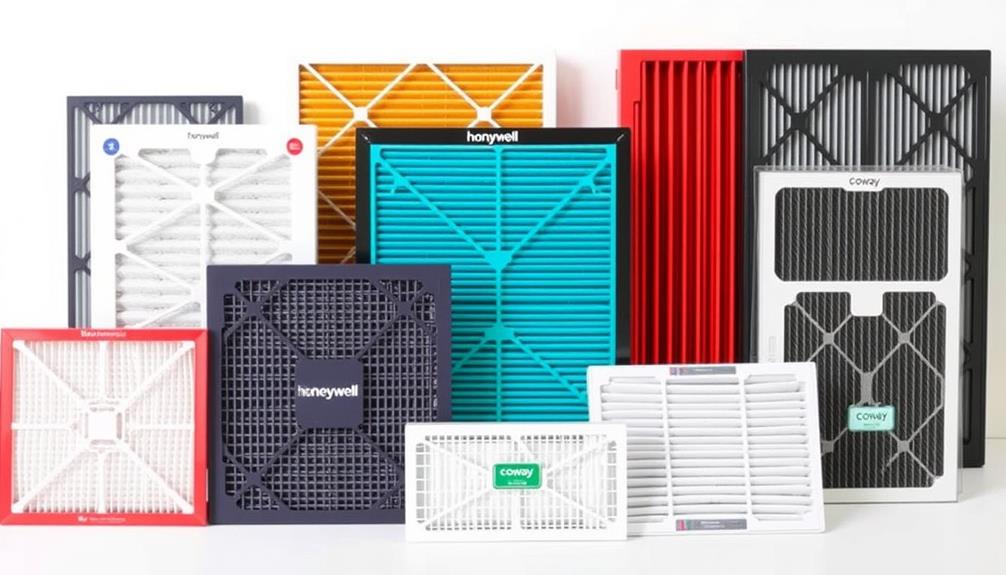
When it comes to selecting an air purifier, several well-known brands stand out in the market. Understanding these brands can enhance your Air Purifier Buying experience and help you make informed choices. Here are some common air purifier brands that you should consider:
| Brand | Price Range | Notable Features |
|---|---|---|
| Alen Corporation | $200 – $800 | True HEPA filters |
| Blueair | $120 – $1,000 | High Air Delivery Rate (CADR) |
| Dyson | $300 – $700 | Advanced technology and design |
| GermGuardian | $60 – $1,000 | Affordability and effectiveness |
| Honeywell | $70 – $500 | Wide availability |
Brands like Coway Airmega and LG are also notable for their innovative technology and efficient solutions. Each of these brands offers a variety of models tailored to different needs, emphasizing features like True HEPA filtration and high CADR ratings. When you explore these options, you can find the perfect air purifier to improve your indoor air quality.
Tips for Optimal Use
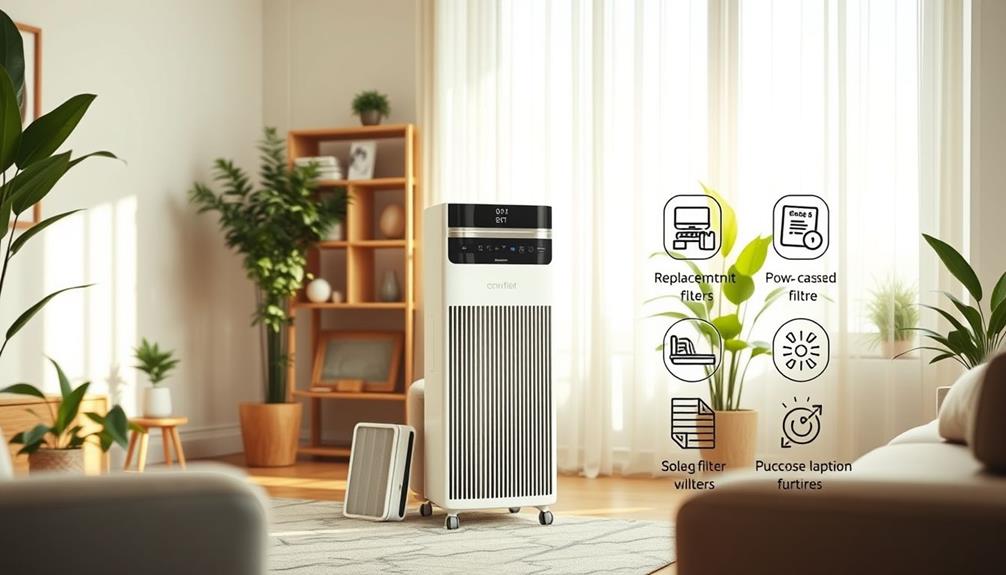
To get the most out of your air purifier, regularly checking the filter status indicator light is essential. Most filters should be replaced every 6-12 months for peak performance. Choosing the right replacement filters compatible with your model guarantees that your purifier maintains its cleaning efficiency.
Here are some tips to enhance your air purifier's effectiveness:
- Use washable pre-filters to capture larger particles, which prolongs the life of your primary filters and reduces maintenance costs.
- Strategically place your air purifier in frequently used rooms, avoiding any obstructions that could hinder airflow.
- Monitor your air quality regularly and adjust the speed settings based on pollution levels. Use higher speeds when you're not around to keep the environment quiet.
Conclusion
In the quest for cleaner air, choosing the right replacement filter can feel like maneuvering through a labyrinth. By understanding your specific needs and the types of filters available, you're not just picking a product; you're investing in your health. Remember, the right filter can be your shield against allergens and pollutants, much like a knight guarding a castle. So, arm yourself with knowledge, keep those filters fresh, and breathe easy knowing you've made the right choice.










